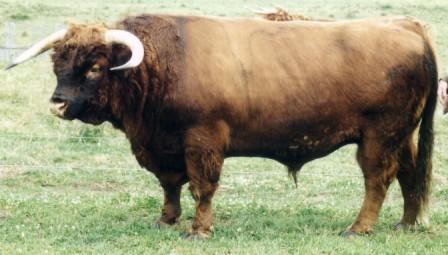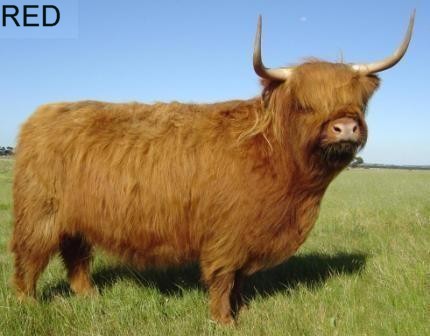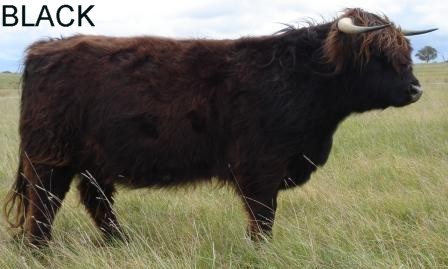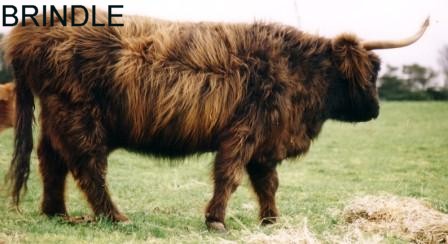Highland Coat Colour Genetics Explained
There is little more perplexing to the Highland breeder than trying to understand coat colour in their animals. Unfortunately knowing a little bit about genetics can sometimes add to the confusion. In this article I will attempt to explain what is known about the genetics behind coat colour in Highlands and some fairly firm thoughts we have on what is as yet unproven. It will be in a simple fashion initially, but links to some more complex concepts will be available as well. This article is written with the help and guidance of Sheila Schmutz from the University of Saskatchewan, Canada who has been an incredible source of information on colour genetics, especially in Highland cattle.
understand coat colour in their animals. Unfortunately knowing a little bit about genetics can sometimes add to the confusion. In this article I will attempt to explain what is known about the genetics behind coat colour in Highlands and some fairly firm thoughts we have on what is as yet unproven. It will be in a simple fashion initially, but links to some more complex concepts will be available as well. This article is written with the help and guidance of Sheila Schmutz from the University of Saskatchewan, Canada who has been an incredible source of information on colour genetics, especially in Highland cattle.
General Concepts on Coat Colour Genes
All cattle have 30 pairs of chromosomes. Along these strings of DNA there are thousands of positions (each one known as a ‘locus’) that contain the genes for all characteristics that make up our cattle. Most genes are exactly the same between all breeds (genes that make a cow a cow, and not a horse), but a small percentage of genes account for the differences between breeds, and between animals of the same breed (like genes for marbling, temperament, horn shape, coat colour etc).
Sadly, there is not just one locus that controls coat colour in cattle. There are actually six major loci, and some other minor loci. In fact it is thought that the six major loci are shared among all mammals to determine their colouring. At each of these six loci there are numerous gene variations (alleles) that, in various combinations, will account for nearly all the colours that we see in Highlands. Currently only certain colour loci have been investigated in Highlands, and a few others in some other breeds. All this goes some way to explain why this is such a complex area to try to understand. There are certain facts that are known about coat colour in Highlands, and others that we can strongly postulate based on evidence from other breeds and the experience of breeders who have seen thousands of calves born.
I will use some nomenclature in these articles that need a brief explanation. The  term ‘wild type’ refers to the default colour of cattle and usually has a default gene at each of the six loci to achieve this colour. Most other colours will be dominant over this ‘wild type’ base colour. The ancient aurochs of Europe (thought to be the ancestors of British breed cattle) were this colour – sort of a red/brown colour.
term ‘wild type’ refers to the default colour of cattle and usually has a default gene at each of the six loci to achieve this colour. Most other colours will be dominant over this ‘wild type’ base colour. The ancient aurochs of Europe (thought to be the ancestors of British breed cattle) were this colour – sort of a red/brown colour.
Each locus has a name and the first letter of that name is the abbreviation for that locus (e.g. the dilution locus is the ‘D’ locus). Each gene (or allele) at a locus will be given a symbol, usually using the letter of the locus and a superscript to define which variation it is is (e.g. E locus genes are ‘E+‘ for wild type and ‘ED‘ for black, and ‘e’ for red). Generally dominant genes are written in capitals, recessive genes are in small letters. At each colour locus, 2 alleles will always exist and are written with a slash between them (E+/E+ or ED/e, e/e for example).
The basics of the six loci are as follows:
| known in Highlands | suspected in Highlands | ||
| ED | black (dominant) | yes | |
| E+ | wild type | yes | |
| e | red | yes |
This is the main controlling locus for the red and black base colours that we see in our cattle. It is thought that wild type and red animals can not be distinguished, although some wild type animals have a classical mask of black hairs on their face, and some black hairs on their neck and legs. We know that all brindle cattle are E+/E+ or E+/e.
| known in Highlands | suspected in Highlands | ||
| Abr | brindle | yes | |
| A+ | wild type | yes | |
| a | black (recessive) | unknown |
The wild type colour here is the agouti colour seen in Jersey cattle. A mutation at this locus has been reported to cause the brindle pattern in Normande cattle (1) and more recently this same gene has been identified in Highlands as the cause of their brindling pattern (Schmutz, personal communication).
| known in Highlands | suspected in Highlands | ||
| K | black (dominant) | ||
| Kbr | brinde | ||
| k+ | wild type | assumed |
Kbr is proven to be the gene controlling brindling in dogs. It has not been identified in Highlands though, so all Highlands are assumed to be K+/K+ at this locus.
| known in Highlands | suspected in Highlands | ||
| Dc | dilutes red & black | yes | |
| d+ | wild type | assumed |
The dilution gene, Dc, was first identified in Charolais cattle, and also Simmental cattle, but a similar mutation at the same locus has more recently been established to dilute red and black colours in Highlands (7). It dilutes red to yellow (one Dc gene) or white (two Dc genes). It also dilutes black to dun (one Dc gene) and silver dun (two Dc genes). This is not necessarily the same as the dilution genes for all other breeds (e.g. the grey colour in Dexter cattle is caused by a different gene).
| known in Highlands | suspected in Highlands | ||
| B | black (dominant) | ||
| b | brown / chocolate | ? |
As yet there is no known influence on Highland cattle colouring at this gene locus. This brown colour is known to occur in Dexter cattle (they appear a rich, reddish brown colour), but in that breed it is confusingly called ‘dun’.
| known in Highlands | suspected in Highlands | ||
| S+ | wild type | assumed | |
| SP | piebald (particolour?) | assumed |
This locus is thought to be involved with most of the white patches that appear in cattle breeds – Pinzgauer colouring, and the piebald colouring of Herefords, Guernseys and Holsteins. This piebald colouring looks very similar to the parti colour colouring that pops up in Highlands from time to time. The white udder or underbelly that we see in some Highlands could have an inherited basis or may simply be a change pigment migration in some animals.
Colours that can be Registered in Australia
 |
 |
| RED |
BLACK |
 |
 |
| YELLOW |
DUN |
 |
 |
| WHITE |
BRINDLE |
Additional Colours that are known to exist in the breed & are genetically separate (but not recognised by the Australian Society);
 |
 |
| MAHOGANY (more about mahogany) |
SILVER DUN |
Related Highland Colour Articles on this website
Anomalies in Highland Coat Colour:
This page covers some of the more unusual coat colours and coat colour patterns that are not fully accounted for in the colours allowed in the herd book. Some of these are accepted and others are not. Either way they are interesting and many breeders ask of them.
Calf Colours:
Just when you thought you had a fair understanding of Highland coat colours, you also need to realise that a number of calves are born different shades or sometimes quite different colours to what they end up being as adults. (see also ‘Mahogany Coat Colour Changes‘ and ‘Black Coat Colour Changes‘)
History of Highland Colour Preferences:
This is a brief discussion of how this has changes over the years. We have bred out, and bred in, certain coat colours in Highlands, because of perceived benefits to certain colours and sometimes just because of fads. For example, around 200 years ago by far the most common colour was black, but this is actually a rare colour amongst Highlands today. Now red is by far the most common and recognised colour.
References:
(1) Cattle Coat Colour Genetics (in depth discussion of genetics involved here.) Sheila Schmutz, University of Saskatchewan, Canada.
The current state of what has been proven by DNA analysis.
(http://munster.sasktelwebsite.net/Cattle/colorgenetics.html)
(2) Galloway Cattle Coat Colour
(http://www.galloway-world.org/intconf/sponen.htm)
(3) Texas Long Horn Coat Colour
(http://doublehelixranch.com/color.html)
(4) Genetics of Cattle, Chapter 3 – Colour Variation, 1999, TA Olson
(5) Coat Colour in Cattle (Beefmasters)
http://www.sss-mag.com/fernhill/cowcolor.html#base
(6) Genetic effects on coat colour in cattle: dilution of eumelanin and phaeomelanin pigments in an F2-Backcross Charolais × Holstein population.
Beatriz Gutiérrez-Gil, Pamela Wiener, and John L Williams.
(7) Genetic Studies Of Coat Colors And Length In Highland Cattle
Tom G Berryere, Ahmad Oulmouden, and Sheila M Schmutz